To-date, I’ve written about all of my snow camping adventures (find them here). All of my posts include useful information and lessons learned about snow camping, but I decided to make a guide to Winter Camping to compile the key things I’ve learned in one place for those debating taking up snow camping! It’s a lot more work than summer camping, but I find it hugely rewarding! Please keep in mind that I am still only a novice snow camper/snowshoer – I always stick to low risk avalanche zones and sleep in a tent – if you’re looking for advice on snow shelter construction or ski touring, you’ll have to look elsewhere.
Safety
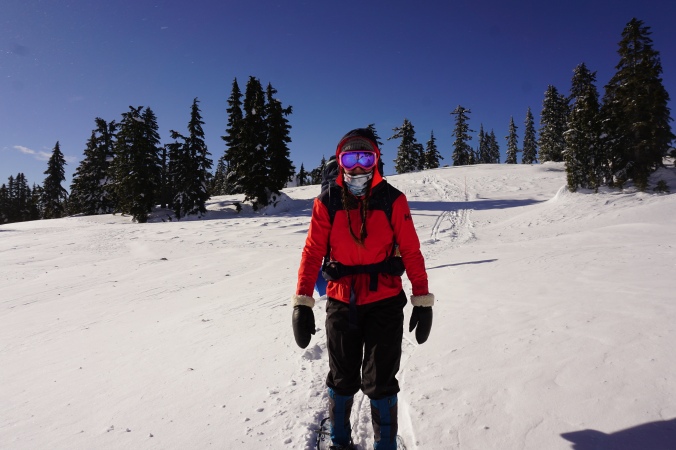
Safety is the number one consideration if you’re thinking of taking up snow camping. I know the pictures of us hanging out and camping in the snow look awesome (at least I think they do, others *Emily* think it looks like a nightmare), but if you think snow camping may be beyond your ability or you’re not prepared, do not go. It’s not something you do for the ‘gram, it’s dangerous. But if you think you’re ready, be prepared with the 10 essentials and lots of warm clothing and sleeping gear. Wear proper footwear and bring lots of hand and foot warmers with you. See my blog post on personal safety for more information about the 10 essentials.
But the most important consideration is avalanche safety. Avalanche Canada is a wonderful resource for assessing avalanche risk and always check it before you go. There are lots of places to snowshoe and camp outside of avalanche terrain, but if we’re going into avalanche terrain, our personal rule is that we won’t go anywhere that’s higher than moderate risk, end of story. We’ve all taken the Avalanche Safety Training and Brandon owns a transceiver, probe, a shovel. Me and Carolyn just own shovels right now, but rent probe and transceiver when needed.
Even with training, we still avoid high risk areas, but taking the training allowed us to learn how to start identifying avalanche terrain and risk so that we are equipped with the knowledge to make decisions. Avalanche safety is about a lot more than just checking the bulletin. Even on days where the risk is low or moderate, you can still trigger avalanches and get into trouble if you don’t understand how to assess the conditions and control your exposure to risk. When in avalanche terrain, it’s not enough for 1 person to be experienced. Everyone needs to be equipped with the proper gear and knowledge.
Gear
I think that gear is probably the biggest bottleneck to getting into snow camping. Camping gear in general is expensive and in the winter you definitely benefit from warm and lightweight gear. It took us a while to get started with snow camping because we were weary of investing in a ton of expensive gear for something we might not enjoy, so we cut a lot of corners and bought some cheap gear to try it out. The downside was that because we loved snow camping, a lot of the gear had to be replaced again, which is a bit wasteful, but can generally be sold secondhand. Plus check what you can get second hand in the first place to help you get started!
My main tip for saving money is to supplement your existing gear. Buy a cheap blue foamy to go under your existing sleeping pad and a warm sleeping bag liner or blanket (or both) to increase the warmth of your existing sleeping bag. The downside is that this is not lightweight and you can expect to have a heavy pack on the first trip. The other alternative is to rent gear, which is a great option if you really think you’re going to love it. See the sections below for more detailed information on specific gear.
Shelter
Shelter is obviously one of the biggest considerations when you’re snow camping and is one of the things that can be the most expensive, or the cheapest. The first time me and Carolyn went out we took my parents ancient 4 season tent, it held up, but was definitely not meant for snow camping and weighed a whopping 10lbs. Fortunately (for us) it was only a 2 person tent and Brandon decided he wanted to be included on these adventures, so he decided to invest in a winter tent so that the 3 of us could go together!
The main feature of a winter tent is that it’s double walled, so basically it has no fly and the poles are exposed, but the double wall and lack of mesh keep you warm inside. Brandon’s tent works great, but it came at a super high price tag, so it’s not practical if you’re just starting out. If this is the case, one thing you can consider is building your own snow shelter. I’d really like to try this some day, but we were a bit overwhelmed with everything we had to learn about snow camping that we didn’t want to add shelter building to the list. It’s something we hope to explore in the future though.
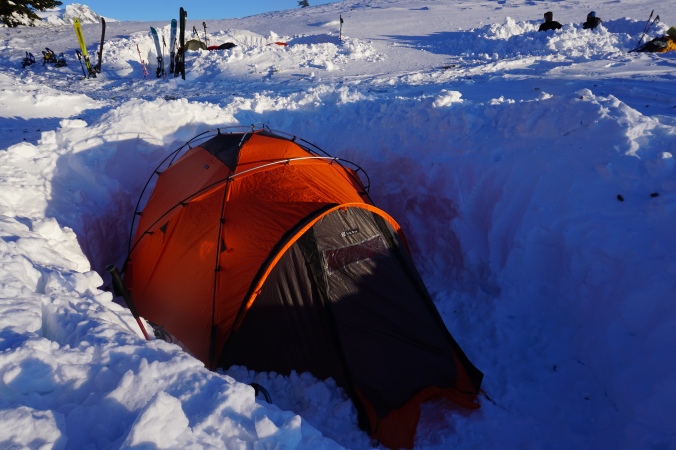
However, even though we use tents, there is still a lot to consider when making camp. You want to protect yourself from the elements as much as possible and of course you can’t just set up a tent on top of powder. We always start with digging a hole big enough for the tent and then stomping down the base with our snowshoes to make it as compact as possible. Location and weather conditions will usually dictate how deep our hole is. I recommend approximately 1 metre, especially if it’s windy because the snow walls will provide a natural shelter, as well as insulation. One tip for when you’re setting your tent up is giving consideration to how you will peg it. In the snow, the risk of losing your pegs is super high, so we either tie rope on the peg, or just skip pegs altogether and bury the rope. The snow will freeze around the rope, so when you’re done, it’s a lot easier to pull the rope out than to dig out frozen pegs.
We have also tried snow camping in a 3 season tent. It’s not ideal, especially if it’s really cold, but if you pack the sides of the tent with snow for insulation, it’s actually not too bad. We made sure to pack the snow up so that it closed the gap between the fly and the inner tent to avoid a draft, but because most 3 season tents are made of mesh, it’s unavoidable that it will be cooler than a true winter tent. Finally, make sure you fill in your hole at the end of your trip to avoid creating a hazard for future users. If the hole fills with powder, it may confuse a skier and could easily result in a broken leg if they don’t know it’s there.
Sleeping
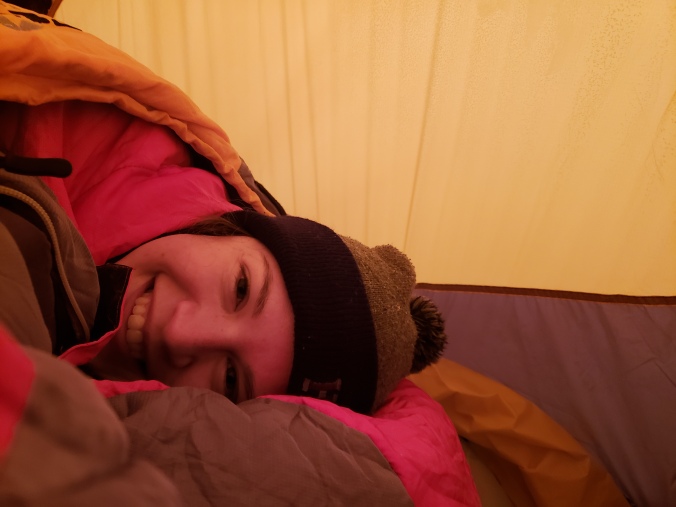
So like I said, when we first started, we cut some corners on our sleeping gear. Depending where you’re going, you’ll want a really warm sleeping bag and a sleeping pad with a combined R-value of 5 or higher. Eventually we all ditched our double pad system in favour of the Thermarest Neoair XTherm, which is rated to R6 and can be used on it’s own. After camping in -20 degrees celsius at Elfin Lakes, Brandon invested in a -30 sleeping bag (Thermarest polar ranger), but Carolyn and I continued to use cheap -15 synthetic bags from Teton paired with a liner and blanket. I’m not going to link the bag because honestly it’s not very good and I think I’d be just as warm in my quality -7 down bag. If you already have a good summer bag (-7 or warmer), you can probably get away with pairing your summer bag with a liner and blankets, provided it’s not super cold. This year me and Carolyn finally gave in and bought North Face’s -29 Inferno bag and Marmot’s -18 Lithium bag respectively and to date, it’s been a lot easier to sleep warm. When picking your bag, I recommend sticking to down and checking what the sleeping bag’s comfort rating is.
I can’t lie, staying warm at night is a lot of work when you’re snow camping. In addition to my gear, I sleep in fleece lined leggings under a pair of pants, several merino layers under a puffy jacket, balaclava, hat, gloves, and socks with slippers. I put foot warmers in my slippers and Carolyn stuffs all her pockets with hand warmers. We also all boil water to put in our nalgene bottles before bed to use as hot water bottles in our sleeping bags. I have an insulator for my nalgene to keep it warm longer.
I take my blanket into the sleeping bag with me (it’s warmer this way and less likely to fall off) and then to finish it off, I overlay my parka over my middle/butt area because I’m a side sleeper and line my snowpants between my bag and the tent to avoid a draft and stay insulated if I accidentally touch the side of the tent. With my new bag, I’m able to leave the liner and blanket at home. It can take a while to get warm in the sleeping bag because it takes a while for your body to heat the space. Try doing sit-ups in your bag right after you get in to warm it up. As a side sleeping, I also recommend starting on your back (it’s warmer this way because your sleeping pad reflects your body heat back at you), then switch to your side once you’re toasty warm.
My last tips are to cocoon into your sleeping bag, but avoid breathing into your bag as this will introduce moisture into your bag, which will make you colder. If you find yourself needing to pee, just get up and do it. Everyone hates getting out of the warm tent, but a full bladder will make your colder and keep you awake. I find that I will usually be a lot warmer after getting up to pee just by virtue of moving around. Your boots will likely freeze overnight, so know that they’ll be a challenge to put on when you leave the tent.
Clothing
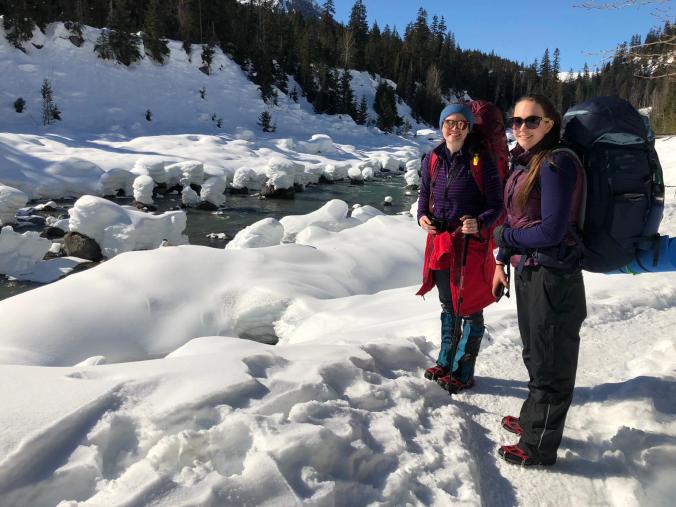
Winter camping is all about layers. You don’t want to dress too warmly on the snowshoe in because you are going to sweat and you want to avoid sweating into all your layers. I usually just wear a thin merino sweater (Costco) under a fleece (Columbia). If I’m still cold or it’s snowing, I’ll add the shell of my ski jacket (but not the liner because it’s overkill). The removable liner was one of the main features I wanted in a winter jacket, I’m on my second “interchange jacket” from Columbia and really like it. I usually start with the shell and ditch either the shell or the fleece once I start sweating (pending if I need the waterproof layer on top). On bottom, I usually wear a pair of tights under my normal water resistant hiking pants. MEC’s sandbagger pants are my favourite and I hike in them in all seasons, although just searching them now I’m sad to find they don’t make the women’s version anymore! Then I pack a pair of snowpants to put on when we get to our campsite and my lightweight puffy for sleeping.
Merino is key when you’re snow camping. It really does still keep you warm when wet and it dries a lot faster than other fabrics. I’ve slowly been accumulating merino layers over the years and one of the best finds for me was switching to merino underwear and bra. It’s expensive and surprisingly hard to come by, but I love how much more quickly they dry. I recommend SmartWool and Icebreaker for merino undergarments. Changing your underwear is really hard and cold in the winter, so switching to merino meant I could go the whole trip (I’ve only done 1 nighters to date) without having to change my base layer. If I did 2 nights, I would bring a second set.
The other trick to winter camping is to bring lots of hats and mittens. Make sure you have a separate toque for sleeping as you don’t want to have to sleep in the hat you’ve been sweating into all day (or is wet from snow). I usually bring several pairs of thin gloves for mobility, a pair of waterproof insulated ski mitts, and another thinner pair of mittens for sleeping.
Footwear
Don’t skimp on footwear. Having a comfortable pair of boots that will keep you warm and dry all day is essential. I used to use a pair of snow boots from Sportchek that had really good waterproofing, but I found my feet would get cold after a while. Lots of boots have temperature ratings and I recommend getting something really warm, but not too bulky if you can avoid it.
Last winter I decided to try snow camping in mukluks and I love them. Manitobah Mukluks is a Canadian, indigenous owned company and I thought who would know better about how to keep your feet warm! I love my muks for warmth, but they can be challenging to pair with snowshoes. They don’t have thick soles like a lot of boots so it’s a challenge to get a really tight fit on the snowshoe, which is another important consideration when picking both your boots and snowshoes. What I do love about these boots though is that they are super warm and because they’re made with natural materials like rabbit fur, they did not freeze on me overnight! Plus a lot of their boots are waterproof – I tested mine snowshoeing in heavy rain for 5 hours and they stayed completely warm and dry!
Being prepared with both snowshoes or microspikes, depending on your trip, is also very important. Most of our snow camping has been done in remote locations with high snow accumulation where snowshoes were definitely required. My snowshoes were from Costco and getting a bit dated, so I picked out a new pair this year, MSR’s Lightning Ascent. The main reason I picked them is because the basket where you connect to your shoe is really comfortable and gets a tight fit to your boot. The straps on a lot of snowshoes can dig into your feet after awhile. Depending where you’re going though, you might be better off with microspikes. We used them when we camped at Keyhole (see photo under ‘clothing’), plus I use them a lot in the shoulder seasons on day hikes. I recommend Kahtoola, but I’ve heard Hillsound is great too.
Cooking
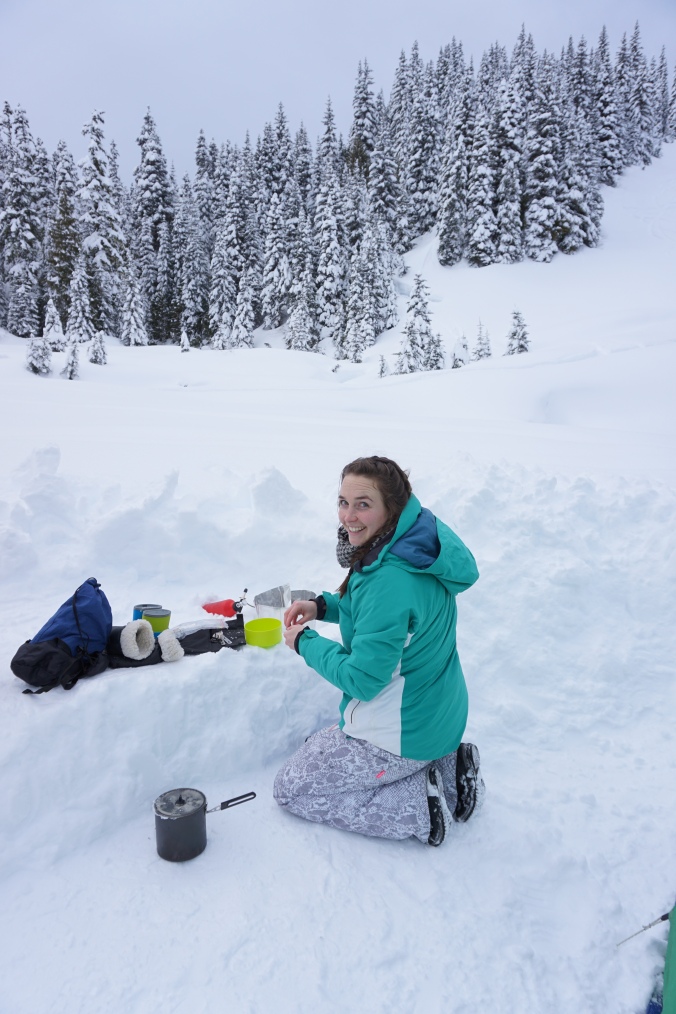
Cooking when snow camping is not that different from backpacking, but there are a few considerations to keep in mind. The first is fuel. Avoid propane and iso-butane mixed gas when snow camping because they can freeze. Stick to white gas stoves if possible or find some way to insulate your fuel canister to keep it warm. Second, up your calorie intake. Being out in the cold for a long time burns a lot of calories, so be prepared with high energy treats that won’t freeze.
The last consideration is water. As I learned on my first trip, melting snow takes a long time and unless its super fresh, it tastes really bad. Melt the snow until its warm and then start adding more to the pot, each time warming it but not boiling. It takes a long time to boil, so once you get enough water, just boil it all at once at the end. It’s not required it you’re boiling it, but consider filtering the water anyways to improve the taste, or bring drink mixes to make it palatable. Also, avoid your platypus on snow trips as the straw will freeze. I usually take a nalgene and a thermos that I pre-fill with tea to keep me warm along the trail. Then I refill my thermos before bed for a nice warm treat when I wake up (or if I get cold overnight).
Building a snow kitchen is one of the fun parts of snow camping though! Plan ahead when digging your hole and pile the snow in one area for your kitchen counter. It’s not a difficult concept, we usually just consolidate the snow into a bit of couch/counter combo so that have somewhere to hang out. I always bring my inflatable sit upon to provide insulation against the snow. We’ll either put the pot right on the counter, or dig a little pit for it if it’s windy.
Bathrooms
Unless you go to Elfin Lakes (or somewhere that caters to winter visitors), it’s unlikely you’re going to have access to an outhouse. Even if where you’re going has outhouses, they’re likely to all be buried in the winter. The good news is, digging a hole is a lot easier in the winter! Just be mindful that your poop is going to stay frozen until Spring, so make sure to use the bathroom somewhere discreet once the snow melts. In winter though, you have to take all your toilet paper with you – there’s no burying paper in the winter.
In some cases, depending on location, you may need to bring a bathroom bag with you to carry your waste out. I’ve written a whole blog entry on backcountry bathrooms, so check it out for more information.
Feel free to ask any questions in the comments, I’m happy to share my experience – snow camping is tough, but it’s rewarding and me, Carolyn, and Brandon look forward to it every year!
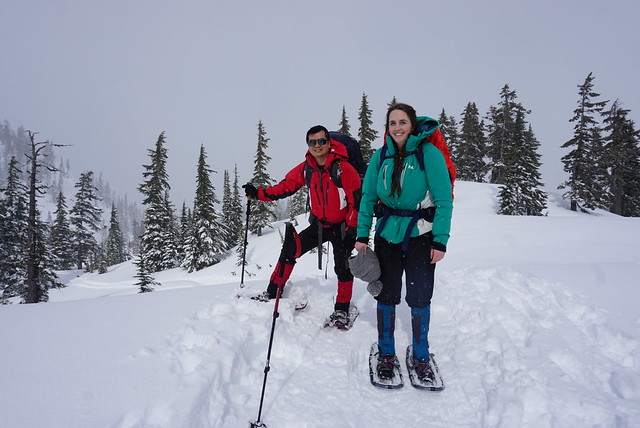
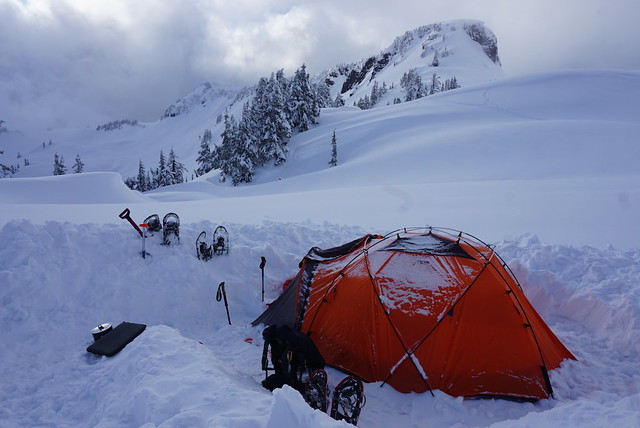
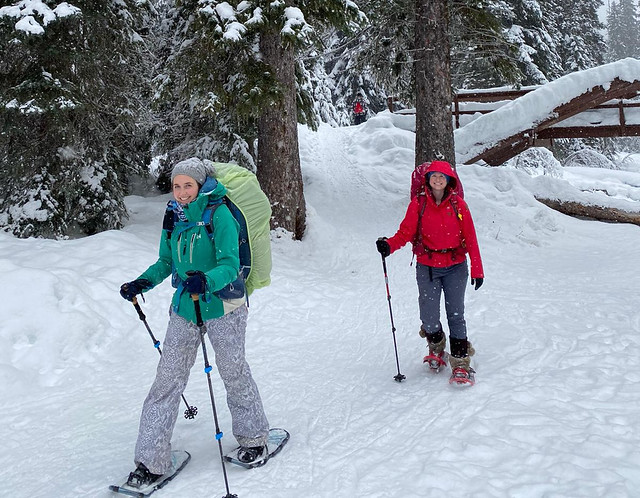
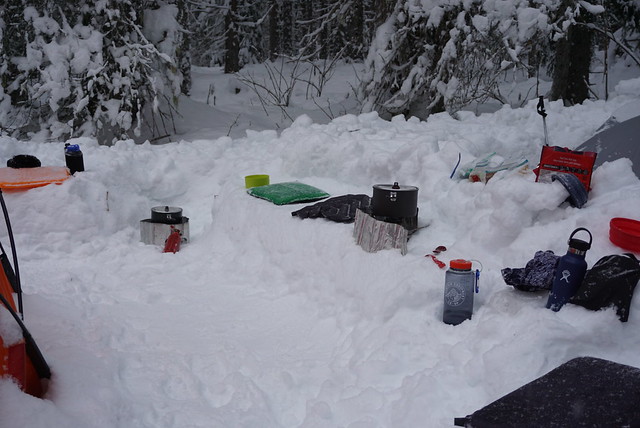
This all makes snow camping sound very fun – and is stuff I would have definitely found out the hard way. It’s a shame snow is always so far away from here!
Is snow camping much more cozy-feeling than regular camping?
Hi Scott! Some people think it sounds awful, but I personally love it!
If you have warm gear, it can be cozy, otherwise it definitely has the potential to just be cold… although with the limited daylight hours you go to bed early and get lots of sleep!
My favourite part is that there are much fewer people in the winter! The only place I’ve ever snow camped where we weren’t alone was at Elfin Lakes. Everywhere else it’s always been just us.